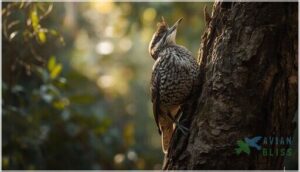This site is supported by our readers. We may earn a commission, at no cost to you, if you purchase through links.
Perched on a branch in the rainforest canopy, the great potoo looks less like a bird and more like a broken tree stump brought to life. This bizarre nocturnal hunter has mastered the art of disappearing in plain sight, fooling predators and prey alike with mottled plumage that mimics bark so perfectly you could walk right past one without ever knowing it was there.
When night falls, those enormous orange-red eyes snap open, transforming this motionless statue into an agile aerial predator that snatches moths and beetles mid-flight.
Found across Central and South America’s tropical forests, the great potoo embodies evolution’s creativity—a bird that’s equal parts camouflage expert, efficient insect controller, and the inspiration behind countless “ghost bird” legends whispered around jungle campfires.
Table Of Contents
- Key Takeaways
- What is The Great Potoo?
- Physical Characteristics of Great Potoo
- Habitat and Geographic Range
- Diet and Feeding Behavior
- Nocturnal and Solitary Lifestyle
- Camouflage and Defense Mechanisms
- Vocalizations and Communication
- Reproduction and Life Cycle
- Conservation Status and Threats
- Cultural Significance and Unique Facts
- Frequently Asked Questions (FAQs)
- What is a great potoo?
- What is the largest potoo?
- What is the scientific name of the Great Potoo?
- What does a great potoo sound like?
- What is a great potoo bird?
- What are some basic facts about great potoo?
- How long has the Great Potoo been around?
- Are potoo birds rare?
- Is the great potoo an owl?
- Why are potoos so scary?
- Conclusion
Key Takeaways
- The great potoo has mastered evolutionary camouflage so effective that its mottled plumage, branch-mimicking posture, and motionless behavior render it virtually invisible against tree bark during daylight hours, protecting it from predators while it roosts in exposed canopy positions.
- This nocturnal specialist hunts using sit-and-wait tactics from fixed perches, launching quick aerial sallies to snatch large flying insects—particularly beetles and katydids—with its disproportionately wide gape, playing a crucial role in regulating insect populations across Neotropical forests.
- Despite its “Least Concern” conservation status, the great potoo faces mounting pressure from deforestation and habitat fragmentation across Latin America, where forest loss eliminates the tall emergent trees and continuous canopy it needs for roosting, nesting, and prey availability.
- The bird’s haunting, low-frequency calls—described as ghostly wails or mammal-like growls—have embedded it deeply in local folklore across Central and South America, where indigenous cultures interpret its vocalizations as omens, lost spirits, or forest phantoms rather than simple territorial communication.
What is The Great Potoo?
The great potoo is one of those birds that stops you in your tracks—not because it’s flashy, but because it’s so impossibly good at hiding in plain sight. This nocturnal hunter from Central and South America has evolved some of the most extraordinary camouflage skills you’ll find anywhere in the avian world.
Let’s break down what makes this species so unique, starting with where it fits in the scientific lineup.
Scientific Classification
You’ll find the great potoo classified under the binomial nomenclature Nyctibius grandis, a designation rooted in taxonomic history stretching back to 1789. This bird species classification places it within Caprimulgiformes through phylogenetic analysis and genus classification that reflects its nocturnal nature:
- Kingdom: Animalia
- Phylum: Chordata
- Class: Aves
- Order: Caprimulgiformes
- Family: Nyctibiidae
Ornithology and avian biology research recognize this species identification as the largest member of its order. The great potoo’s habitat and behavior are influenced by its native Central America regions.
Overview of The Species
The great potoo (Nyctibius grandis) stands as the largest among potoo bird species—a nocturnal master of disguise haunting Neotropical forests from southern Mexico to Brazil. This unique bird classification reveals wildlife adaptations that’ll make you look twice: arboreal habits, strictly nighttime hunting, and that eerie ability to vanish against tree bark.
It’s a species introduction to nature’s most underrated ghost. The great potoo’s habitat and behavior are closely tied to its role as an insectivorous bird species, which is a key aspect of its survival in the tropical forests.
Distinguishing Features
When you spot a great potoo, you’ll notice its disproportionately large head and that frog-like mouth extending far beyond the short, hooked beak—perfect for snatching insects mid-flight.
Those forward-facing eyes glow orange-red at night, while mottled gray-brown plumage patterns break up the bird’s outline completely.
Add rictal bristles framing that wide gape, and you’ve got facial structure built entirely for nocturnal ambush hunting.
Physical Characteristics of Great Potoo
The great potoo’s appearance is a masterclass in nature’s design for survival. From its deceptively stout build to the intricate patterns that make it virtually invisible, every aspect of this bird’s physical form fulfills a purpose.
Let’s break down the key features that make the great potoo one of the most uniquely adapted birds in the Neotropics.
Size, Weight, and Wingspan
When you encounter a Great Potoo perched motionless in the canopy, you’re looking at one impressive bird.
Adults generally measure 48–60 cm (about 19–24 inches) in length, with body proportions perfectly adapted for their aerial hunting lifestyle. These medium-sized nocturnal specialists weigh between 360–650 grams—roughly one to one-and-a-half pounds—and boast wingspans stretching 70–80 cm (28–31 inches) across, with minimal size variations between sexes.
Plumage and Camouflage
The Great Potoo’s plumage reads like a masterclass in deception—mottled whites, grays, browns, and burgundies blend seamlessly with Neotropical bark, while 8–9 white tail bars shatter your ability to trace its outline. This bark mimicry isn’t just color matching; it’s visual disruption at work, turning a 60-cm bird into invisible wood.
The Great Potoo’s mottled plumage doesn’t just match bark—it disrupts your vision entirely, turning a two-foot bird into invisible wood
Key Camouflage Strategies in Great Potoo Feather Patterns:
- Mottled marbling mimics lichen-covered bark surfaces with striking precision
- Fine vermiculation creates texture matching weathered wood grain perfectly
- White barring breaks up body contours, preventing predator shape recognition
- Minimal color variation across sexes maximizes cryptic effectiveness for both
- Dappled plumage exploits patchy forest light, blending into sun-shade patterns
When you’re searching canopy perches, remember: these bird characteristics evolved specifically to exploit your visual weaknesses, making detection nearly impossible without movement or sound.
Eye and Beak Adaptations
You’re staring at evolution’s night-vision goggles: proportionally massive eyes with rod-packed retinas that grab photons like desperate bargain hunters, while eyelid slits let these nocturnal birds surveil threats without breaking their branch disguise.
That absurdly wide beak—extending past eye level—creates an aerial insect net, coordinating with visual acuity to intercept prey mid-flight. It’s functional art optimized for darkness.
| Adaptation Feature | Structural Specialization | Functional Advantage |
|---|---|---|
| Eye Size & Position | Large corneal diameter, lateral placement | Enhanced light capture; wide aerial surveillance |
| Retinal Composition | High rod-to-cone ratio, reflective layer | Exceptional nocturnal vision; detection at low thresholds |
| Eyelid Slits | Narrow notches permitting light passage | Daytime monitoring while maintaining cryptic posture |
| Beak Gape Width | Commissure extending past eye; broad opening | Maximized prey capture area during hunting tactics |
| Eye-Beak Coordination | Forward visual sectors align with gape strike | Precise interception of flying insects against sky |
Habitat and Geographic Range
The great potoo isn’t a bird you’ll spot just anywhere—it has carved out a specific niche across the Americas. From the humid lowlands of southern Mexico down through the heart of the Amazon and into southeastern Brazil, this nocturnal specialist knows exactly where it wants to be.
Let’s break down where you’re most likely to find one and what kind of terrain they call home.
Countries and Regions Found
You’ll find great potoos (Nyctibius grandis) stretching across an impressive swath of the Neotropics—from southern Mexico all the way down to southeastern Brazil and Bolivia. This geographic distribution reveals their adaptability within tropical rainforest ecology, with regional variations appearing throughout Central America and South America.
Key Country Profiles across their range:
- Central America: Belize, Costa Rica, Guatemala, Honduras, Nicaragua, and Panama support stable populations
- Northern South America: Colombia, Venezuela, and the Guianas harbor extensive populations within Amazonian forests
- Western interior: Ecuador, Peru, and Bolivia represent important Andean-foothill range sectors
- Eastern extent: Brazil contains the largest national portion, extending through multiple forest biomes to Paraguay
Preferred Habitats and Elevation
You’ll spot these birds primarily in dense lowland tropical rainforest ecology below 500 m, though their elevation range extends to roughly 1,500 m in foothill zones. They’re masters of forest edge ecology, exploiting clearings and second-growth areas where tree canopy usage remains dense.
Habitat fragmentation doesn’t deter them completely—they’ll use plantations and agricultural edges if vertical nesting sites persist, maintaining ecological balance through structural flexibility in wildlife habitat selection.
Adaptation to Environment
You’re witnessing environmental adaptations that blur the line between bird and bark. Their mottled plumage delivers camouflage techniques so effective that forest ecology transforms them into living wood—a mastery of arboreal survival.
Nocturnal strategies shift their perch heights nocturnally, optimizing nocturnal bird behavior for insect-rich zones. This animal adaptation maintains ecological balance across wildlife habitats while demonstrating avian biology’s most cunning defense: absolute stillness that defies detection.
Diet and Feeding Behavior
Great potoos are precision hunters that have evolved to dominate the night sky in their forest domains. Their diet revolves around whatever flies within striking distance, and they’ve perfected a hunting style that’s equal parts patience and explosive action.
Let’s break down what these nocturnal predators eat, how they capture their meals, and the role they play in keeping their ecosystems balanced.
Primary Food Sources
You might think nocturnal birds stick to small prey, but great potoos break that mold entirely. These aerial hunters target large flying insects—especially beetles, katydids, crickets, and grasshoppers—that dominate Neotropical forest canopies after dark.
Insect composition drives their nocturnal foraging strategy, though they’ll occasionally snag bats or small birds mid-flight. Their diet and foraging habits position them as critical regulators in food chains, controlling populations of larger flying invertebrates across their range.
Hunting Techniques
Great potoos master sit-and-wait ambush tactics, perching motionless on exposed branches where camouflage strategies blend them into bark. When flying insects pass within striking range, they launch quick sallies—darting from their perch to snag prey mid-air with that famously wide gape.
Nocturnal hunting peaks during bright moonlight (76-100% illumination), when these nocturnal birds leverage superb low-light vision to intercept beetles and katydids with precision.
Role in The Ecosystem
Beyond their impressive hunting skills, great potoos regulate insect populations through sustained predation pressure on beetles, katydids, and other large-bodied arthropods—a textbook example of trophic cascades shaping forest dynamics.
You’ll find them linking multiple species interactions: they’re both predators of flying insects and occasional small vertebrates, and prey for arboreal mammals targeting their nests.
This dual role strengthens ecological balance and biodiversity across Neotropical canopies, supporting wildlife conservation priorities in tropical ecology.
Nocturnal and Solitary Lifestyle
Great potoos live life on their own terms, moving through the darkness with a kind of purpose that most of us never get to see. When the sun’s up, they transform into living sculptures, masters of staying still and blending in.
Let’s break down how these birds navigate their double life—active hunters by night, invisible statues by day.
Nighttime Activity Patterns
When darkness falls, you’ll find great potoos transforming into silent hunters. These nocturnal birds shift from tall daytime roosts to lower nighttime perches—just 1.5 to 5 feet above ground—where they wait motionless for prey. Their nocturnal animal behavior centers on aerial sallies: launching quick strikes to snatch beetles, katydids, and even bats mid-flight before returning to the same branch.
Four key patterns define their moonlight foraging:
- Solitary nocturnal hunting throughout the entire night from fixed perches
- Silent flight powered by long wings for maneuverability through forest gaps
- Sit-and-wait tactics using keen night vision to detect flying insects
- Repeated perch use, often returning to favorite hunting spots nightly
This sedentary strategy reflects striking animal adaptations for nighttime efficiency.
Daytime Camouflage Strategies
When the sun rises, you’ll see the great potoo’s survival tactics reach masterclass level. They freeze into vertical, branch-mimicking postures on exposed perches, aligning their bodies with broken stumps while bark-like feather patterns blur the line between bird and tree. Even their eyes close to narrow slits, hiding telltale shine. This cryptic behavior makes them nearly invisible—observers often pass within meters without noticing these masters of visual concealment.
| Camouflage Technique | Physical Adaptation | Behavioral Strategy |
|---|---|---|
| Branch Mimicry | Mottled brown-gray plumage | Vertical stump posture held motionless |
| Background Matching | Bark-like feather patterns | Perch selection on 20-30cm diameter branches |
| Ocular Concealment | Cryptically patterned eyelids | Eyes closed to slits during daylight |
Social Behavior
You’ll rarely catch these birds mingling—great potoos are textbook loners. Solitary roosting defines their territorial use, with single birds spaced across perches. Monogamous pairs form only during breeding, when parental care demands cooperation.
Vocal communication bridges the gap between isolated individuals at night, with haunting calls carrying through forests to advertise territory or contact mates. Outside nesting, they’re nature’s hermits.
Camouflage and Defense Mechanisms
When you’re a bird that spends daylight hours sitting completely exposed on a bare branch, you’d better have some serious tricks up your sleeve. The great potoo has evolved one of nature’s most impressive disappearing acts, relying on a combination of specialized physical features and behaviors that make it nearly invisible to both predators and prey.
Let’s look at the three key strategies that allow this extraordinary bird to vanish in plain sight.
Cryptic Plumage Adaptations
You’ll find that the great potoo’s plumage patterns are evolutionary masterpieces—mottled gray, brown, and white tones mirror weathered bark with uncanny precision. The feather structure incorporates irregular streaks and vermiculations that fragment the bird’s outline, creating outstanding visual concealment.
This color mimicry extends to fine details resembling lichen patches, transforming the potoo into living wood during daylight hours when predators hunt by sight.
Motionless Posture and Mimicry
When danger looms, you’ll witness one of nature’s most intricate freeze responses—the great potoo transforms into a living sculpture. This branch mimicry relies on visual deception so convincing that even experienced observers walk past without noticing:
- The bird holds an upright “broken branch” posture for 10–15 minutes without flinching
- Body alignment creates vertical continuity with dead wood and lichen-covered bark
- Motionless hunting postures eliminate recognizable avian silhouettes entirely
- Disturbance triggers intensified stillness rather than flight, demonstrating impressive camouflage strategies
Avoidance of Predators
Predator evasion in great potoos blends nocturnal defense with strategic positioning. You’ll find them roosting 8–20 meters high on exposed branches, well beyond the reach of terrestrial hunters like coatis and ocelots.
Their threat response involves heightened vigilance through slit-like eyelid openings, allowing them to monitor danger without breaking their branch mimicry.
These survival strategies reflect animal adaptations honed across millennia, where camouflage tactics and habitat selection determine life or death in bird behavior and wildlife conservation efforts.
Vocalizations and Communication
If you’ve ever heard a great potoo’s call echoing through the forest at night, you’ll understand why locals have woven so many legends around this bird. Their vocalizations are as distinctive as their appearance—haunting, deliberate, and impossible to mistake for anything else.
Let’s break down what these calls sound like, why potoos use them, and how people have interpreted these eerie sounds over time.
Description of Calls and Sounds
If you’ve ever wandered through a Neotropical forest at night, you might’ve heard what sounds like a ghostly growl echoing through the canopy—that’s the great potoo’s signature call. These nocturnal sounds are unlike typical bird songs, with vocalizations featuring deep, mournful wails that show exceptional acoustic adaptations for long-distance animal communication:
- Reverberating roar that carries hundreds of feet through dense forest
- Frog-like “baaaao” mixed with an eerie “whoap” in their call patterns
- Low-frequency sound waves that create mammal-like growls
- Harsh, guttural timbre dominating the nocturnal soundscape
- Clicking and rattling occasionally added to their bird behavior repertoire
Purpose of Vocalizations
When you hear that haunting wail cutting through the darkness, you’re witnessing nature’s perfectly tuned broadcast system. Great potoos use vocalizations primarily for territorial defense and mate location—those low-frequency acoustic signals announce “this forest patch is mine” to rivals while helping separated pairs reconnect across dense canopy. During threat responses, they’ll switch to grunts and rattles, adapting their nocturnal communication strategy to match the situation.
| Call Function | Purpose & Context |
|---|---|
| Territorial Defense | Loud moans mark boundaries and warn rival potoos away from occupied ranges |
| Mate Location | “Whoap” calls help partners coordinate movements in dark, cluttered forests |
| Breeding Communication | Vocal activity peaks during reproductive seasons for pair bonding |
| Threat Signaling | Grunts and clicks serve as alarm responses when predators approach |
| Environmental Timing | Calling intensifies under specific moonlight conditions and during early night hours |
Human Perceptions of Calls
Those territorial calls serve biological functions, but they’ve earned the potoo a reputation as one of nature’s most unsettling performers. You’ll find its nocturnal sounds described across cultures as everything from ghostly wails to demonic shrieks—reactions that reveal more about human psychology than bird behavior and ecology.
Common human interpretations of potoo vocalizations:
- Folklore associations link calls to lost spirits—Shuar communities hear “aishirú” (my husband), while Brazilian traditions name it “Mãe-da-lua” for its melancholic cries
- Eerie vocalizations dominate modern reactions, with hikers describing them as “angry fox gargling” and social media amplifying their terrifying calls as prehistoric nightmares
- Cultural symbolism transforms scientific bird watching observations into omens—villages still view the “Ave Fantasma” as a death harbinger when its nocturnal sounds pierce the darkness
Reproduction and Life Cycle
Great potoos approach reproduction with the same minimalist philosophy they apply to everything else—no fuss, no elaborate nests, just one carefully placed egg high in the canopy.
Both parents share the workload from incubation through chick-rearing, using their cryptic appearance to shield their offspring from predators.
Here’s how their breeding cycle unfolds from courtship to independence.
Breeding Season and Pairing
When tracking breeding cycles in Great Potoos, you’ll notice they are seasonal nesters whose timing shifts with local climates—February to August in Panama, and July to December in Brazil’s Pantanal.
These monogamous birds form strong pair bonds that last beyond a single season, using nocturnal vocal duets and gentle bill snapping as courtship behaviors. Both partners share territory defense throughout their extended association.
| Breeding Aspect | Key Details |
|---|---|
| Mating System | Monogamous pairs with long-term bonds |
| Courtship Behaviors | Vocal duets, bill snapping, nighttime calls |
| Seasonal Timing | Varies regionally (2-7 months per year) |
Nesting Habits and Egg Characteristics
Once paired, Great Potoos skip nest-building entirely—you’ll find their single egg laid directly in a shallow notch or tree branch depression, usually 10+ meters high. Nest site selection favors exposed, horizontal limbs where the adult’s bark-like plumage provides camouflage.
- Clutch size: Always one egg per attempt
- Egg camouflage: White with subtle brown spotting resembling lichen
- Incubation period: Roughly 30 days with shared parental duties
Chick Development and Parental Care
Once the egg hatches, you’re witnessing a classic example of shared parental roles—both adults alternate day shifts brooding their fluffy chick while delivering insect prey after dark.
The nestling period stretches about 55 days, with chick growth accelerating through feather development stages. By week five, your young potoo has mastered the iconic “broken branch” pose, and fledging stage arrives near the two-month mark.
Conservation Status and Threats
The great potoo isn’t on the edge of extinction, but that doesn’t mean it’s safe from the pressures reshaping its world.
Right now, the species sits in a relatively stable position, though quiet threats are chipping away at its forest strongholds.
Here’s what you need to know about where this bird stands today and what’s putting it at risk.
IUCN Red List Classification
You might wonder how threatened the Great Potoo truly is—turns out, not much. According to the IUCN Red List Criteria, this bird species sits comfortably at Least Concern status, reflecting its broad geographic distribution across Central and South America.
The Species Evaluation shows stable global rankings despite local declines, as current Threat Assessment data doesn’t indicate the severe population drops needed for higher-risk Wildlife Conservation categories.
Impact of Deforestation
Across the Great Potoo’s range, forest fragmentation chips away at everything this bird needs to survive—tall trees for roosting, dense canopy for camouflage, and abundant night-flying insects. Since 2002, Latin America has lost over 60 million hectares of tropical primary forest, and that habitat loss translates into real trouble:
- Tree clearance removes essential roosting and nesting sites high in the canopy
- Ecosystem disruption alters microclimate, making fragments hotter and drier
- Biodiversity decline reduces prey availability as insect communities collapse
- Edge effects from fragmentation undermine camouflage effectiveness
- Habitat destruction isolates populations, especially at distribution edges
You’ll find Great Potoos becoming uncommon or locally rare wherever slash-and-burn agriculture and industrial clearing fragment their lowland forest home. Even moderate-scale habitat loss reshapes forest structure within decades, eliminating the large emergent perches these sit-and-wait hunters depend on.
While their conservation status remains globally stable, local populations face drastic decreases—a pattern threatening wildlife preservation efforts across the Neotropics. Forest fragmentation doesn’t just shrink habitat; it rewrites the entire ecological playbook for species like this that evolved in continuous, undisturbed canopy.
Conservation Efforts and Protected Areas
Throughout the Great Potoo’s vast Neotropical range, you’ll find habitat preservation anchored in millions of hectares of protected landscapes—national parks in Brazil and Peru, Amazonian reserves in Colombia, and community-managed conservation areas that safeguard canopy forest.
These wildlife refuges don’t target Great Potoos specifically, but conservation policies protecting tall-tree ecosystems deliver exactly what this nocturnal hunter needs: continuous forest and biodiversity management that sustains prey populations.
Cultural Significance and Unique Facts
Beyond the science and stats, the great potoo has carved out a fascinating place in human culture—especially in the regions where its eerie calls echo through the night.
Local communities have woven this strange bird into their folklore, and some of its behaviors are just too bizarre not to highlight.
Let’s look at how this bird has captured imaginations and what makes it truly one of a kind.
Folklore and Legends
If you’ve stumbled across the great potoo online, you know its wide-eyed stare fuels meme culture and social media buzz—but long before viral fame, this nocturnal animal starred in far stranger stories.
Ghost bird myths across South America cast it as a wandering spirit or lost soul. Forest spirit tales in Brazilian Tupi–Guarani traditions call it “urutaú,” the phantom of the forest. You’ll find legends claiming its haunting cry echoes abandoned lovers searching for their partners, or children calling for lost parents.
Some communities even harvest its feathers for magical uses, believing they protect chastity and ward off seduction. Nocturnal omens? Absolutely—potoo calls still signal mysterious forest events in rural folklore and wildlife preservation conversations alike.
Role in Local Cultures
In rural Brazil and Paraguay, the great potoo sits at the crossroads of cultural symbolism and indigenous beliefs. You’ll find it woven into ritual practices far removed from today’s meme culture.
Communities hunt it not for food but for feathers believed to guard chastity, embedding mythical significance into wildlife preservation challenges.
Folklore legends frame it as both protector and omen, shaping how locals navigate nocturnal forests and interpret animal adaptations and habitat.
Notable Behaviors and Traits
You might think the great potoo’s frozen pose is just camouflage, but it’s a calculated survival tactic. When threatened, this nocturnal bird doesn’t flee—it angles its beak skyward and becomes a “broken branch,” exploiting unique feathers and cryptic plumage to vanish in plain sight.
Its aerial hunting involves short, precise sallies from the same perch repeatedly, a signature behavior among solitary nocturnal animals mastering animal adaptations and habitat challenges.
Frequently Asked Questions (FAQs)
What is a great potoo?
The great potoo (Nyctibius grandis) is a large nocturnal bird native to Central and South American tropical forests, known for its remarkable camouflage, haunting vocalizations, and sit-and-wait hunting style.
What is the largest potoo?
Among all potoo species, Nyctibius grandis stands tallest. The great potoo claims the title of largest bird species in its family, reaching 60 centimeters and 650 grams.
What is the scientific name of the Great Potoo?
The binomial nomenclature for this exceptional nocturnal hunter is Nyctibius grandis. Johann Friedrich Gmelin first described it in 1789, with the Latin epithet “grandis” meaning “large”—perfectly capturing its status as the largest potoo species.
What does a great potoo sound like?
You’ll hear a low-frequency moaning wail between 500–1,000 Hz—think human-like groans echoing through darkness.
Great Potoo vocalizations carry long, drawn-out notes lasting 1–2 seconds, creating one of nocturnal birds’ most unsettling audio profiles.
What is a great potoo bird?
You’re looking at the largest member of the potoo family—a nocturnal bird species from Central and South America renowned for its outstanding camouflage, haunting calls, and striking hunting adaptations.
What are some basic facts about great potoo?
Despite its haunting reputation, the great potoo (Nyctibius grandis) thrives quietly across diverse habitats from Mexico to Brazil.
It adapts remarkably to conservation challenges while remaining elusive to wildlife research efforts tracking nocturnal bird species characteristics.
How long has the Great Potoo been around?
The Great Potoo’s evolutionary history stretches back over 40 million years, with fossil records from the Eocene period revealing ancient lineage roots.
Species divergence within Nyctibiidae shows this bird’s genetic origins predate most modern avian biology developments.
Are potoo birds rare?
Is rarity about how many exist or how often you’ll spot one? Great potoos aren’t globally rare—the IUCN Red List marks them as Least Concern—but they’re locally uncommon, with habitat loss and their nocturnal, cryptic nature reducing encounters across their broad distribution.
Is the great potoo an owl?
No, you might think so because of those owllike eyes and nocturnal habits, but taxonomic debate settled it—the great potoo belongs to Nyctibiidae, not owl families in Strigiformes, making species distinctions clear.
Why are potoos so scary?
Nocturnal fears run deep in humans, and when you combine ghostly legends with a bird species that has owl-like eyes glowing in darkness, fearful encounters feel inevitable—especially when their ominous behavior includes sudden movements from perfect camouflage.
Conclusion
Like a ghost that only reveals itself when the stars take their shift, the great potoo reminds us that survival often means becoming invisible—until the moment you strike. You’ve journeyed through its cryptic world of bark-perfect camouflage, moonlit hunts, and haunting calls that echo through disappearing forests.
Now you understand: protecting these silent sentinels means preserving the wild spaces where darkness still holds its mysteries, and where evolution’s strangest masterpieces can vanish into the branches they call home.















